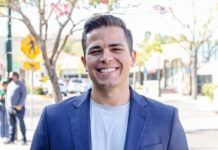Gary Junker has been taking photographs for more than 30 years. His specialty is large format prints, some of which are currently on display at the Chula Vista Cardiac Center, located at 321 E St. in Chula Vista.
The medical practice is owned by cardiologists Brett Berman, M.D., and Vitali Aizin, M.D. Junker, who works full-time as a medical ultrasound technician, met the doctors through his work in echo cardiography at Scripps Mercy Chula Vista Hospital.
He did not hesitate to contribute some of his photography when asked.
Junker’s work occupies one corner of the large and well-lit waiting room. Berman and Aizin believe that artwork has a calming effect on patients as they wait for their appointments. Berman said studies have shown that such a calming effect can lead to a drop in blood pressure of anxious patients.
Junker said he enjoys his work in the medical profession, but his side line in photography is equally rewarding, especially from an esthetic sense.
Junker studied large format 4×5 photography at Grossmont College. After graduating college, Junker began working in the news industry as a photographer. Many of his assignments were spot news, which requires a quick eye to survey the scene and get the right composition for a good photograph.
The same can be said for photographing natural subjects, including landscapes, which are among his favorites.
Junker draws inspiration from the work of famed American photographer and environmentalist Ansel Adams.
With photography, lighting is everything. Photographing landscapes deals with ambient light, such as how shadows fall at different times of the day, and cloud movement.
Working with large format prints — 24×36 inches — requires precision visualization as to what the photographer desires in the final print.
Junker likes to tell a story in one shot.
“It makes you think about what will really make a good photograph,” he said.
Since developing and printing 4×5 film is “a lot of work,” he said, the goal is to set up a good photograph from the start.
One of Junker’s most elegant photographs is of a dilapidated car in the middle of a field of weeds at night in the ghost town of Bodie in the high Sierras. The snaking Milky Way presents a striking backdrop.
In order to remain on the property after nightfall, Junker had to get a special permit. He also had to bundle up. The temperature that October night was 16 degrees.
“That’s probably the most photographed car in the world,” Junker said.
But his photograph is unique.
Junker spends much of his time photographing landscapes in the southern Sierras near Lone Pine. He has shot extensively in the Alabama Hills and the Mt. Whitney area.
One of Junker’s photographs on display is that of the Mobius Arch taken in the Alabama Hills.
The Manzinar concentration camp, where more than 110,000 Japanese Americans were forcibly removed during World War II, presented Junker with another remarkable image for his portfolio.
The camera is close to the ground and the landscape is filled with a sea of countless pebbles and rocks leading to the distant horizon. It is stark in its beauty and raw in its emotion.












